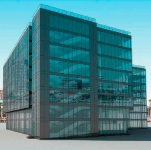Uponor TAB: Thermo-Active Construction Systems

Text by Tati ana Ushkova, photos provided by Uponor Great attention is paid today to arrangement and maintenance of optimum habitat. This requires consideration of climate and the landscape, situation and orientation of a structure, materials of walls and floors, water-supply and air conditioning systems, energy sources. Heating and cooling of office and habitable spaces are believed to be the important components of comfortable residence. The way of reaching maximum comfort with minimum energy consumption is being clarified by Alexei Bazhukov, manager on water supply and the heating systems at Uponor.
What kind of products does Uponor offer to Russian customers?
Uponor is the world leader in production of polymeric and metalpolymer pipeline systems, which are widely applied in building industry. It is possible to use them for padding of both external and internal engineering services. We generally offer the solutions for water supply, heating, cooling, and also treatment facilities. Now we actively promote at Russian market the innovation system of Thermally-Active Building Systems (Uponor TAB), which is intended for interior air cooling. We consider this direction well promising, because, according to estimation of our European expert, the air conditioning market will be growing by 5% per year due to global warming.
Tell us, please, about the purpose and the features of the Thermally- Active Building Systems.
As a matter of fact, this system serves as alternative to the traditional interior air conditioning, which has a number of well known deficiencies. This is rather high air speed within accommodation, moreover, this is cold air, which might be harmful to human health; occasional noise accompanying air flow through ventilation ducts and plafonds. In terms of medicine the dusty or overdried air, propagation of harmful bacteria causes the increased risk of respiratory diseases. Another drawback is aesthetic ugliness of ducts, which beside spoiling the interior appearance accumulate dust, whilst fans require recurrent maintenance.
The Uponor TAB system is intended for cooling air in accommodations via radiant heat exchange between cooled surface of structural unit (for example, floor) and interior air. I.e., the cold floor takes away heat from air in the daytime, whilst the floor itself gets cold at night. This method is also called surface cooling. Its kernel consists in the fact that the temperature of floor surface is lower than that of interior air, thus occurs the socalled temperature drop (difference between the temperature of air and that of floor or wall surface). The temperature drop results in extracting heat away from accommodation.
However, cooling of the floor itself is achieved by water circulation along the serpentine pipeline inside reinforced concrete floor or wall. Strictly speaking, water serves as the coolant, which takes away heat from the floor slab, which itself plays the role of cold storage battery. This is the basic principle of operation of our Uponor TAB system.
How is the process of cold production regulated?
The special calculation of desirable comfortable cooling of structural is produced in the course of designing of particular system. The refrigeratory output of a slab is determined, with regard to how it satisfies the needs of certain accommodation with specified number of persons and units of equipment. It is a must to consider the region of building’s location. Depending on desirable volume of cold accumulated within the floor the time of coolant (water) circulation parameters is determined (speed, temperature). This is done at the design stage and in the course of operation the values are maintained automatically. There is a maximum, which floor is able to accumulate. However, if calculations show that the storage maximum of overlap does not meet the cooling needs of accommodation, it is possible to complement cooling capacity with traditional cooling system. In this case the additional system will be less powerful than if the TABS is not deployed, and consequently, more economical.
In order to remove the danger of formation of moisture (dew point), the cooled surface is equipped with special automation with the controllers and the sensors controlling the temperature of water in the serpentine pipes. Sensors are installed either on pipe itself or on the cooled surface. And if the sensors register approximation of the surface temperature to the dew point, on this alert signal the controller gives the command to cutoff valve to cease supplying the serpentine pipes of the TAB system with coolant. It is necessary to consider that we propose to accumulate cold in the floor at night, since during this period the temperature of outer air is much lower than in the daytime. As a result the efficiency of refrigerator becomes much better. Therefore at night it is possible to cool reinforced concrete floor to the desired temperature, and in the daytime to disable coolant circulation. As a result during in the daytime the floor system returns cold accumulating heat. Because of massiveness the reinforced concrete floor slabs accumulate much cold, thus enhancing energy-effectiveness of a building. But this does not mean blockage of coolant circulation in the daytime. Just in terms of economic effectiveness it’s more reasonable to design it presuming accumulation of cold only at night. But if calculations prove that cooling capacity is insufficient for this particular accommodation and additional cold is still needed, the system may keep on operating in the daytime, making thus the process of cooling permanent.
Full version you can download here
 Text by Tati ana Ushkova, photos provided by Uponor
Text by Tati ana Ushkova, photos provided by Uponor


